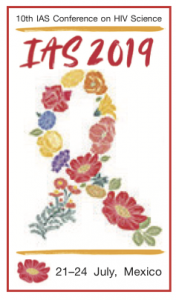Dual therapy with islatravir (MK-8591) plus doravirine: 24 week results as switch strategy
24 July 2019. Related: Conference reports, Antiretrovirals, IAS 10 Mexico City 2019.
 Simon Collins, HIV i-Base
Simon Collins, HIV i-Base
A late-breaking oral abstract at IAS 2019 included the first results of a new dual therapy of the investigational NRTTI islatravir plus the NNRTI doravirine, compared to triple therapy with additional lamivudine (3TC). [1]
This was part of a phase 2b study for treatment naïve participants who initiated ART with islatravir, doravirine and 3TC and who switched to dual ART at week 24 if viral load was undetectable (<50 copies/mL). Participants taking longer than 24 weeks were able to switch when then did become undetectable. Week 24 results were already presented at IAS 2019 and reported separately. [2, 3]
This was a randomised, double-blind, comparator-controlled, dose-ranging trial (using 0.25 mg, 0.75 mg or 2.25 mg once-daily doses of islatravir). This compound has a long intracellular half-life ~120 hours with potential for weekly and perhaps monthly dosing.
Primary efficacy endpoints included the overall proportion of participants at week 48 with viral load < 50 copies/mL by FDA snapshot analysis. The results at 48 weeks (following 24 weeks on dual ART) were presented by Jean-Michel Molina from St Louis Hospital, Paris.
Baseline characteristics included mean age 31 years, 93% male. Mean CD4 count was 492 cells/mm3 (SD: 188) and 22% had viral load >100,000 copies/mL. Race included 76% white and 20% black but the study also referred to approximately half the participants being Hispanic or Latin American. Approximately 40% were treated in sites in North America, 30% in South American and 25% in Europe.
At week 48, five participants in the islatravir arms (4 rebound, 1 non-response) vs one in the control arm (viral rebound) had viral load levels that were >50 copies/mL. However, no participants had viral load rebound >200 copies/mL and all were reported as being <80 copies/mL. This was below the threshold to test for drug resistance and no new drug resistance was reported. Mean CD4 increases were similar in all groups.
Tolerability was generally good. Drug-related AEs were reported less frequently for the combined dual therapy arms compared to triple drug control group (7.8% vs 19.4%).
From week-48 all participants in the islatravir groups were changed to the 0.75 mg dose (for follow up until week-96) – although the dose to take forward into phase 3 studies has not yet been announced.
The study concluded that dual therapy would continue to be studied.
Table 1: Viral load responses after week 48: dual ART for 24 weeks,
| ISL 0.25mg + DOR | ISL 0.75 mg + DOR | ISL 2.25 mg + DOR | doravirine /3TC/TDF |
|
| n | 29 | 30 | 31 | 31 |
| d/c before wk 24 | 0 | 0 | 4 | 3 |
| d/c wk 24-48 | 2 | 1 | 3 | 2 |
| <50 c/mL wk 48 | 89% (26/29) | 90% (27/30 | 77% (24/31) | 84% (26/31) |
| > 50 c/mL wk 48 | 7% (2/29) | 7% (2/30) | 13% (4/31) | 7% (2/31) |
| No data | 3% (1/29) | 3% (1/30) | 10% (3/31) | 10% (3/31) |
References
- MolinaJ-M et al. MK-8591 at doses of 0.25 to 2.25 mg QD, in combination with doravirine establishes and maintains viral suppression through 48 weeks in treatment-naïve adults with HIV-1 infection.10th IAS Conference on HIV Science (IAS 2019), 21-24 July 2019, Mexico City. Late-breaker oral abstract WEAB0402LB.
http://programme.ias2019.org/Abstract/Abstract/4789 - MolinaJ-M et al. Tolerability, safety and efficacy of MK-8591 at doses of 0.25 to 2.25 mg QD, in combination with doravirine and lamivudine through 24 weeks in treatment-naïve adults with HIV-1 infection. 10th IAS Conference on HIV Science (IAS 2019), 21-24 July 2019, Mexico City. Late breaker post abstract LBPED46.
http://programme.ias2019.org/Abstract/Abstract/4694 - Collins S.Islatravir (MK-8591) in new fixed dose combination (FDC) with doravirine plus lamivudine: 24 week results. HTB July 2019.
https://i-base.info/htb/36398

